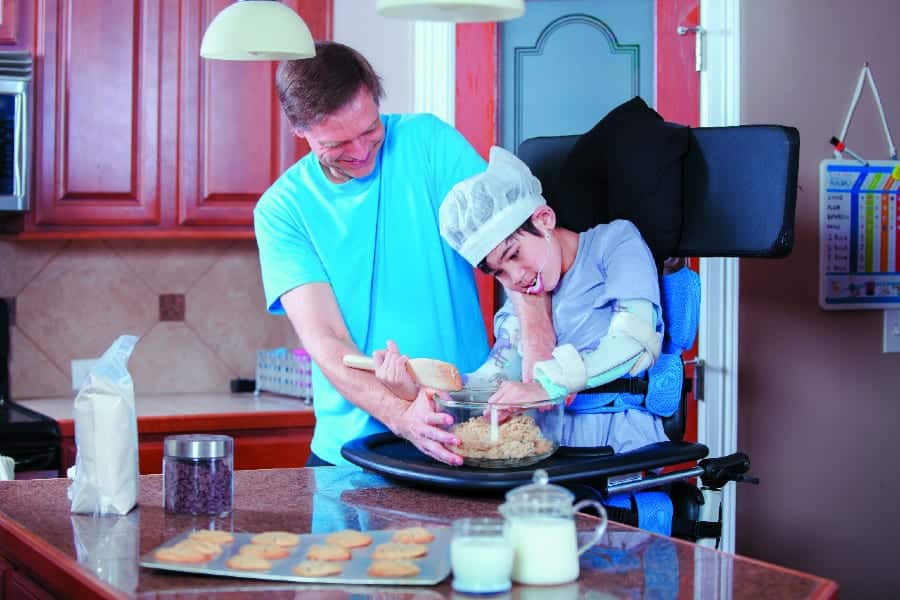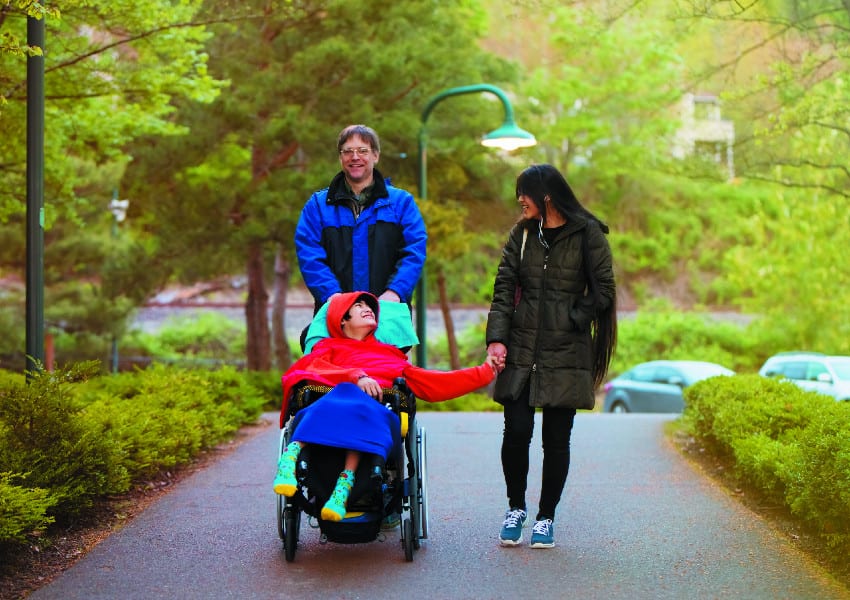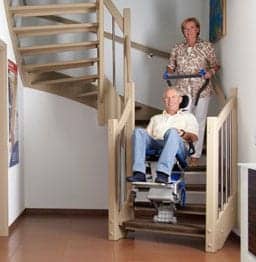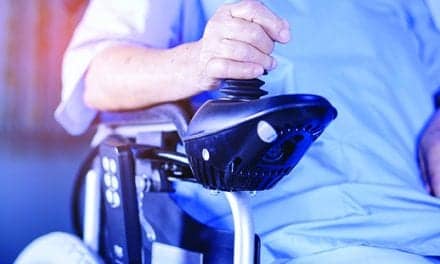The selected equipment should not only fit the client anatomically but also match his or her physical, social, and contextual environments.
by Kirsten Davin, OTD, OTR/L, ATP, SMS
The pediatric mobility arena, which encompasses not only wheelchair seating and positioning, but also standers, gait trainers, and a plethora of other equipment options, has witnessed many recent and notable improvements. Enhanced design, advanced technologies, and increased variety in personalization options have broadened the range of available features and subsequently resulted in additional equipment combinations and enhanced client outcomes that were previously unattainable. Along with these advancements and the opportunity to acquire additional features and products comes an often-overlooked need to ensure the selected equipment will be a perfect fit for the client, both anatomically, in regards to the manner in which the client fits within the equipment, as well as comprehensively, considering how the equipment fits within the client’s physical, social, and contextual environments.
While the number of seating, positioning, and pediatric specialists continues to increase within the rehabilitation community, it is reassuring that the process of fitting the client to the selected equipment continues to be streamlined and is currently at the highest standard ever witnessed. Unfortunately, many clinicians are still unfamiliar with the concept of equipment desertion and technology abandonment, and therefore lack in taking the additional step of ensuring the equipment pairs well with the client’s various environments.
Equipment desertion, also known as technology abandonment, is defined as the discontinuance of use of an assistive technology device. While these terms often hold a negative connotation, in actuality, equipment desertion or technology abandonment can occur as a result of positive variables such as improvement of the client’s medical status, resulting in a reduced need for equipment. Termination of use may also ensue as a result of various negative factors, including but not limited to a change in the client’s health status, limitations in the physical environment that were not addressed at initial evaluation, transportation concerns, societal influences, and most commonly, subpar communication during evaluation, equipment fitting, and training as well as a lack of inclusion of the client and caregivers in the decision-making process. Currently, technology abandonment reportedly occurs at a rate of 15% to 20% within the United States.

Predicting Abandonment
Researchers who have sought to understand the causes of abandonment have noted that changes in the needs of users are important predictors. Such changes can be permanent (eg, cerebral palsy, resulting in an inability to perform ambulation), temporary (eg, increased hypertonia, which can be addressed with medication adjustment), or fluctuating (eg, fluctuation in attention and focus). These fluctuations, some of which are expected, may be accommodated by adjustable technologies, designed to accommodate for the changing needs of the user, his or her situation, or medical status. It is sometimes this difficulty with configuration and modification of assistive technologies that leads to technology abandonment. Difficulties in configuring and modifying the settings of an assistive technology will often lead to abandonment.
Equipment Considerations: Wheelchairs
Current trends in manual and power pediatric wheelchair design have afforded today’s clients with the benefits of lighter, faster, more responsive manual wheelchairs along with the utmost in cosmetic variety, including styling, colors, and design, which hold a greater appeal to pediatric populations. This advancement in design and technology, including the ability for some power seat functions to lower the seat to floor level, has simultaneously eradicated some of the previously known reasons for technology abandonment, including frame weight and limitations in maneuverability as well as greatly improved client satisfaction by addressing socialization and peer-interaction capabilities.
Many parents choose to have at least one manual wheelchair for their child to utilize because of their simplicity combined with multiple positioning options, which makes them a versatile option, thus reducing the risk of dissatisfaction which could occur with a sole manual or power option.
Gait Trainers
Gait trainers serve a pivotal role in aiding the mobility and stability of pediatric clients as they help develop, maintain, or rehabilitate ambulation capabilities. Like other products in the industry, gait trainers have evolved into lighter-weight and more accommodating designs, including hands-free styles to improve the client’s ease in mobility and successful outcomes.
These developments, including the transition to lighter, more adjustable dynamic trainers to better simulate gait patterns and development, provide the user with improved support, stability, and proper postural alignment, aiding in the reduction of equipment desertion and improved goal achievement.
Crawl Trainers
Crawl trainers are specifically designed to encourage, develop, and reinforce crawling skills in pediatric clients. Their design allows the caregiver or therapist to assist the client with movement in a supported quadruped position, comparable to crawling. Gait trainer and crawl trainer devices hold the fewest reports of negative technological abandonment, due in part to the fact that their use is intermittent and not consistent like a stroller or wheelchair. The gait and crawl trainers hold the highest ratings of positive technological abandonment since often, clients will progress from requiring the use of these devices to crawling independently or ambulating with the use of a walker or alternative device.
Standers
Offering greater mobility to the caregiver for brief mobilization of the client, as well as dynamic features—including styles which offer a sit-to-load option and can transition the child from a seated position to a standing position with ease—standers have long offered pediatric clients the ability to bear weight and stand with assist. Standing is a necessary activity that, if at all possible, must be encouraged in pediatric clients. There are a variety of documented health benefits of standing, including but not limited to: improved lower extremity strength; improved physiological function, including respiratory, cardiac, and urinary system benefits; and improved psychological and emotional health and participation in peer activities.
Recent advancements in stander loading options, ranging from standers that manually transition the child from a seated or supine position into standing to those that make the sit-to-stand transition via powered access, have improved client and caregiver satisfaction and increased the overall benefit of the incorporation of standers.
Adaptive Strollers
Adaptive strollers offer pediatric clients with special needs the opportunity to explore and participate in the world around them while remaining safe, appropriately supported, and free from the restrictions that are sometimes associated with wheelchair use, including limitations in outdoor use due to rough terrain, uneven surfaces, and frame weight.
One of the more challenging transitions for parents and caregivers is often the transition of the pediatric client from stroller use to wheelchair use. Parents are frequently hesitant to transition from an adaptive stroller to full-time wheelchair use, perhaps for fear of an anticipated increased stigma with wheelchair use or, as reported by some parents of pediatric clients, facing the reality that their child may be a long-term wheelchair user and accepting the diagnosis’ far-reaching ramifications. Methods to improve parental acceptance of the stroller-to-wheelchair transition may include education about the benefits a wheelchair, either power or manual, has over a stroller as the pediatric client grows. Such benefits include an improved ability to self-propel independently (if applicable), resulting in increased functional independence and participation in everyday tasks, including school activities.

Methods to Prevent Technology Abandonment
Regardless of the equipment being implemented, there are several common factors that should be considered in an effort to avoid technology abandonment.
• Attempt to avoid assistive technologies that cannot accommodate to the changing needs of users, including a change in medical status, performance ability, desired tasks or activities, weight, height, or other physical attributes. Assistive technology devices that are unable to accommodate, or costly to accommodate, are most likely to be abandoned as an obstacle to assistive technology retention is reconfiguration of the device.
• Ensure the assessment of the technology is an ongoing process. Remember, changes in the client’s functional abilities or desired activities may result in a need for adaptation of the equipment. A common falsehood that is often accepted within the healthcare community is that a user only needs to be assessed once for assistive technology equipment. In reality, a significant cause of technology abandonment is the lack of an ongoing reassessment, which leads to equipment that is ill-fitting or mismatched to the client’s needs, abilities, or physical capabilities.
• Recommend and issue equipment based on the client’s current capabilities as opposed to what the client is anticipated to be able to do. For example, do not issue a manual wheelchair if the client cannot currently self-propel, but hopes to someday. In the event the client’s goals are unfortunately not achieved, this would render the equipment useless and possibly result in equipment desertion.
• Incorporate all parties into the assistive technology assessment and equipment-obtainment process, including the client, his or her caregiver or parent, a school representative, transportation representative, physical and occupational therapists, and anyone else who works closely with the pediatric client. Often, technology abandonment is not a result of client dissatisfaction but a result of outside environments in which the client will be using the chair, or outside parties who will be required to assist the client with the technology being issued.
Equipment desertion and technology abandonment result in hundreds of thousands of lost healthcare dollars as well as limited outcomes for pediatric clients annually. Through the use of a combination of new technologies, the presence of unprecedented equipment adaptability and a comprehensive approach to client assessment, equipment selection and intervention, the risk of such abandonment or desertion may be significantly reduced, resulting in improved outcomes for the user. RM
Kirsten Davin, OTD, OTR/L, ATP, SMS, an occupational therapist of nearly 20 years and expert in the seating/positioning industry, currently serves as a Clinical Assistant Professor and Academic Fieldwork Coordinator for Baylor University’s OT Doctorate Program. For more information, contact [email protected].
This article appeared in the March 2020 print edition of Rehab Management with the title Beyond the Fit.
Related article by Kirsten M. Davin — Anterior Trunk Supports: Achieving Greater Function Through Torso Control
Click here for continuing education about Anterior Support Theory and Application by Kirsten M. Davin





